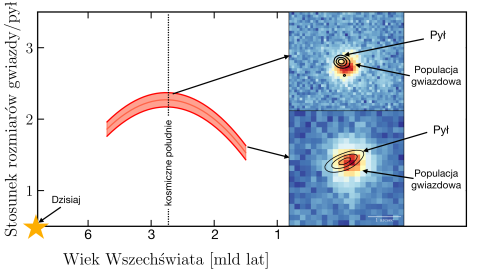
Unveiling the hidden stars: ALMA Shines a Light on Dust Attenuation
15-06-2023
Interstellar dust is a key component in galaxies. It favors star formation and drives the chemistry and physics of the interstellar medium. However, it hides the majority of stars in a way that it is impossible to observe them. Astrophysicists use dust attenuation laws that would uncover these hidden stars by reverse-engineering the light from galaxies to quantify how many stars are there.
Star-to-dust compactness as a function of the age of the Universe. The distribution peaks around the cosmic noon.
Astrophysicists are trying to estimate how much of the ultraviolet and visible light emitted by stars in dusty galaxies is absorbed by dust and then re-emitted in the infrared range. However, for decades, the problem was that the laws governing the processes of radiation attenuation by dust were not sufficiently known. There was a lack of knowledge about what this process depends on. The situation changed when a group of astrophysicists found a hidden correlation between dust and the shape of galaxies.
An international team of researchers has made new findings about the dusty star-forming galaxies at distances larger than 10 Billion years from us. They have studied over a hundred of heavily dust-obscured galaxies in the early Universe, and investigated the attenuation of radiation by dust using various physical aspects. The team was led by NCN Preludium grant winner Mahmoud Hamed, along with his supervisor, another NCN grant holder, SONATA BIS, and team leader at Astrophysics Division of NCBJ, Prof. Katarzyna Małek. Close collaboration between the National Centre for Nuclear Research in Warsaw, Poland, and the Laboratoire d’Astrophysique de Marseille in Southern France, used cutting-edge technical analysis in order to answer the decade-standing question: What is the form of the law governing processes of dust attenuation processs in galaxies residing in the young universe?
The team discovered that the estimated physical properties of super dusty ultra-massive galaxies (~10 times more massive than our own Milky Way!) strongly depend on the models used to describe dust attenuation in the analysis. The ground-breaking discovery in this complete study was that the way dust dims the stars is strongly correlated with the shape of galaxies observed at different wavelengths. The analysis results showed that in the case of a compact distribution of stellar populations in galaxies, consistent with the distribution of dust, the influence of dust on their perception can be explained using a simple attenuation law, without the need to assume complex geometries of stars and dust. This greatly simplifies the calculations and analysis of the physical properties of these galaxies. On the other hand, the team has found that when the sizes of stellar population areas are significantly smaller than the sizes of dust areas, complex features in dust attenuation laws must be included in order to explain the amount of dust in these objects. Roughly speaking, taking into account the relative compactness of star-to-dust emission is crucial, especially since the type of attenuation law used may strongly affect our interpretation of key elements in these galaxies such as how massive they are.
Moreover, the curve of relative size evolution between stars and dust was found, shockingly, to peak around the cosmic noon (an interesting epoch of the Universe, when galaxies did nothing besides forming stars massively). These new findings give a huge insight into the nature of dusty star-forming galaxies when the Universe was adolescent, which is critical for understanding galaxy evolution. The research team hopes that their study will inspire future research to investigate dust attenuation in the era of grand instruments such as the James Webb Space Telescope (JWST) and the Atacama Large Millimetre/submillimetre Array (ALMA).
Original paper:
The slippery slope of dust attenuation curves Correlation of dust attenuation laws with star-to-dust compactness up to z = 4
M. Hamed, K. Małek, V. Buat, Junais, L. Ciesla, D. Donevski, G. Riccio, and M. Figueira
Astronomy & Astrophysics: https://doi.org/10.1051/0004-6361/202245818
available also at: https://arxiv.org/pdf/2304.13713.pdf







